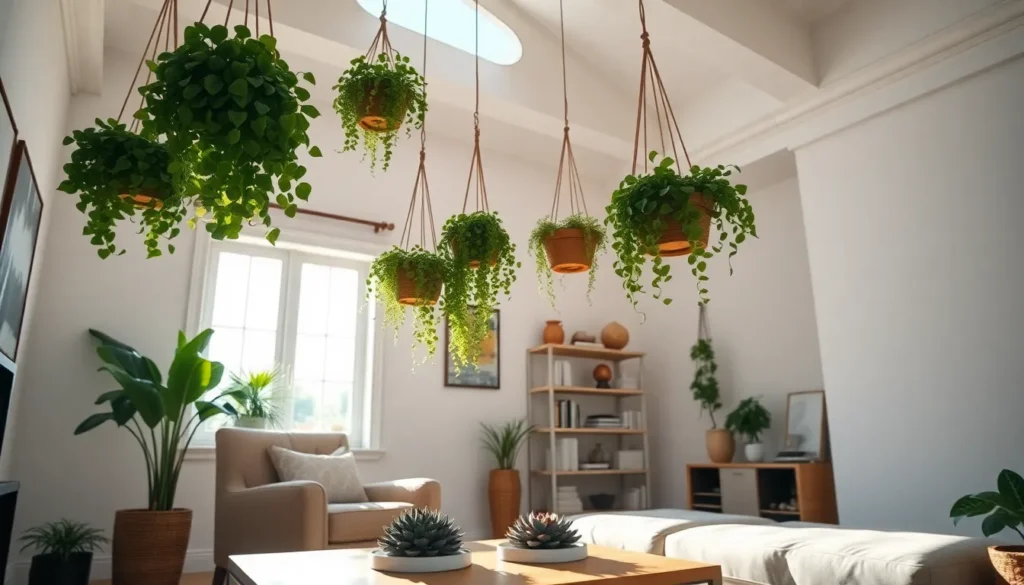Transforming your living space into a green oasis doesn’t require extensive floor space or expensive renovations. Hanging plants from the ceiling offers an elegant solution that maximizes vertical space while creating stunning visual appeal throughout your home.
We’ve discovered that ceiling-mounted plants don’t just save precious square footage – they completely revolutionize how we experience our indoor environments. From trailing pothos cascading gracefully in your living room to air plants suspended above your kitchen island, these elevated gardens bring life to previously unused spaces.
Whether you’re working with a cramped apartment or simply want to add dramatic flair to your home décor, ceiling plants deliver impressive results. We’ll show you exactly how to select the perfect plants, choose the right hanging systems, and create breathtaking displays that’ll have your guests wondering how you became such a green-thumb expert.
Choose the Right Ceiling Structure for Hanging Plants from Ceiling
Before installing your green oasis overhead, we need to ensure your ceiling can safely support the weight of hanging plants from ceiling installations. The structural integrity of your ceiling determines the success and safety of your vertical garden project.
Identify Load-Bearing Points
Locate ceiling joists using a stud finder to find the strongest mounting points for your hanging plants. We recommend tapping across the ceiling surface to identify hollow versus solid areas, as joists typically run 16 or 24 inches apart in most homes. Electronic stud finders provide the most accurate readings for wooden joists behind drywall or plaster surfaces.
Mark joist locations with pencil before drilling any holes for your hanging plant hardware. These structural beams can support 20 to 50 pounds per mounting point depending on the wood type and joist size. We always verify joist direction by checking multiple points along the suspected beam path.
Avoid mounting between joists unless you’re using specialized hollow wall anchors rated for plant weights. Standard drywall anchors support only 10 to 15 pounds maximum, which isn’t sufficient for most hanging plants from ceiling installations with soil and water.
Test Ceiling Material Strength
Determine your ceiling type by examining the surface texture and checking building records if available. Drywall ceilings require different mounting approaches than plaster, concrete, or exposed beam ceilings. We find that plaster ceilings often crack around mounting points if not properly reinforced.
Perform a small test drill in an inconspicuous area to assess material density and thickness. Standard residential drywall measures 0.5 to 0.625 inches thick, while plaster can range from 0.375 to 1 inch depending on the application method. Concrete ceilings need masonry bits and specialized anchors for secure mounting.
Check for ceiling damage like water stains, cracks, or sagging areas that could compromise mounting strength. We inspect the area above through attic access when possible to verify structural soundness before installing hanging plants from ceiling systems.
Consider Professional Installation for Heavy Plants
Hire a contractor for plants exceeding 25 pounds including pot, soil, and plant weight when fully watered. Professional installers have experience with structural calculations and appropriate hardware selection for your exact ceiling type. We recommend getting quotes from at least two contractors familiar with indoor plant installations.
Schedule installation during dry weather to prevent moisture complications during the mounting process. Contractors can install reinforcement blocking between joists if needed to distribute weight across multiple structural points. Professional work typically includes warranty coverage for both installation and structural integrity.
Request load calculations from your installer to document the weight capacity of your hanging plants from ceiling system. This documentation proves valuable for insurance purposes and future plant additions to your vertical garden setup.
Select the Best Hardware for Hanging Plants from Ceiling
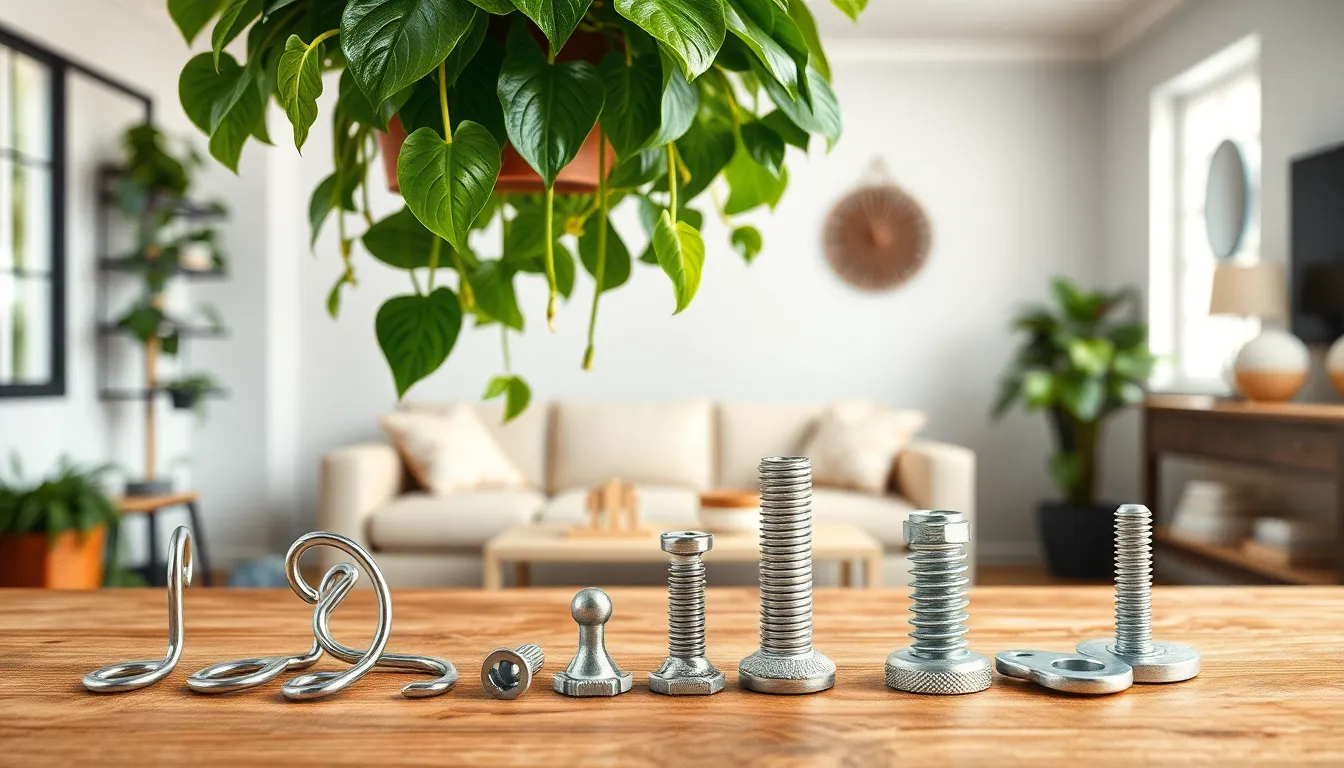
Choosing the right hardware makes the difference between a successful hanging plant display and potential ceiling damage. We’ll explore three proven hardware options that ensure your plants stay securely suspended while protecting your ceiling structure.
Eye Hooks and Screws for Lightweight Plants
Eye hooks provide the most straightforward solution for hanging lightweight plants from ceiling joists or wooden beams. We recommend these simple hardware pieces for plants weighing less than 10 pounds, as they screw directly into solid wood surfaces without requiring additional support mechanisms.
Installation involves drilling a pilot hole first, then screwing the hook clockwise until it sits flush against the ceiling surface. These hooks work exceptionally well in rooms with exposed beams or when you’ve located ceiling joists using a stud finder. The direct wood-to-metal connection creates a reliable anchor point that won’t shift over time.
Screw hooks offer similar benefits with slightly different threading patterns designed for various wood types. We find these particularly effective for hanging small pothos, air plants, or lightweight ceramic planters that add greenery without stressing your ceiling structure.
Toggle Bolts for Drywall Installation
Toggle bolts solve the common challenge of hanging plants from drywall ceilings where joists aren’t accessible. We use these spring-loaded anchors when installing medium-weight plants that exceed the capacity of standard drywall anchors but don’t require joist-level support.
The installation process requires drilling a hole large enough for the toggle wings to pass through, then inserting the bolt assembly until the wings expand behind the drywall. These wings distribute the plant’s weight across a larger surface area, preventing the concentrated stress that causes drywall failures.
We recommend toggle bolts for plants weighing 10-25 pounds, including hanging baskets filled with soil or multiple small plants grouped together. The expanded wings create a secure mounting point that rivals joist-mounted installations when properly sized for your exact plant weight.
Ceiling Anchors for Maximum Support
Ceiling anchors that engage directly with joists or beams provide the strongest mounting option for heavy plants or multiple plant arrangements. We combine heavy-duty swag hooks with hinge clips to create a system that distributes important weight while maintaining long-term structural integrity.
These anchor systems work by transferring the plant’s weight directly to load-bearing ceiling members rather than relying on drywall or surface materials. We install them by first locating the joist, then using specialized hardware that clamps or screws into the structural wood for maximum holding power.
For installations supporting plants over 25 pounds or multiple hanging arrangements, we always recommend this joist-engaged approach. The hinge clip mechanism prevents the hardware from working loose over time, while the heavy-duty construction handles the ever-changing loads created by watering, plant growth, and air circulation.
Pick Perfect Plants for Hanging Plants from Ceiling Displays
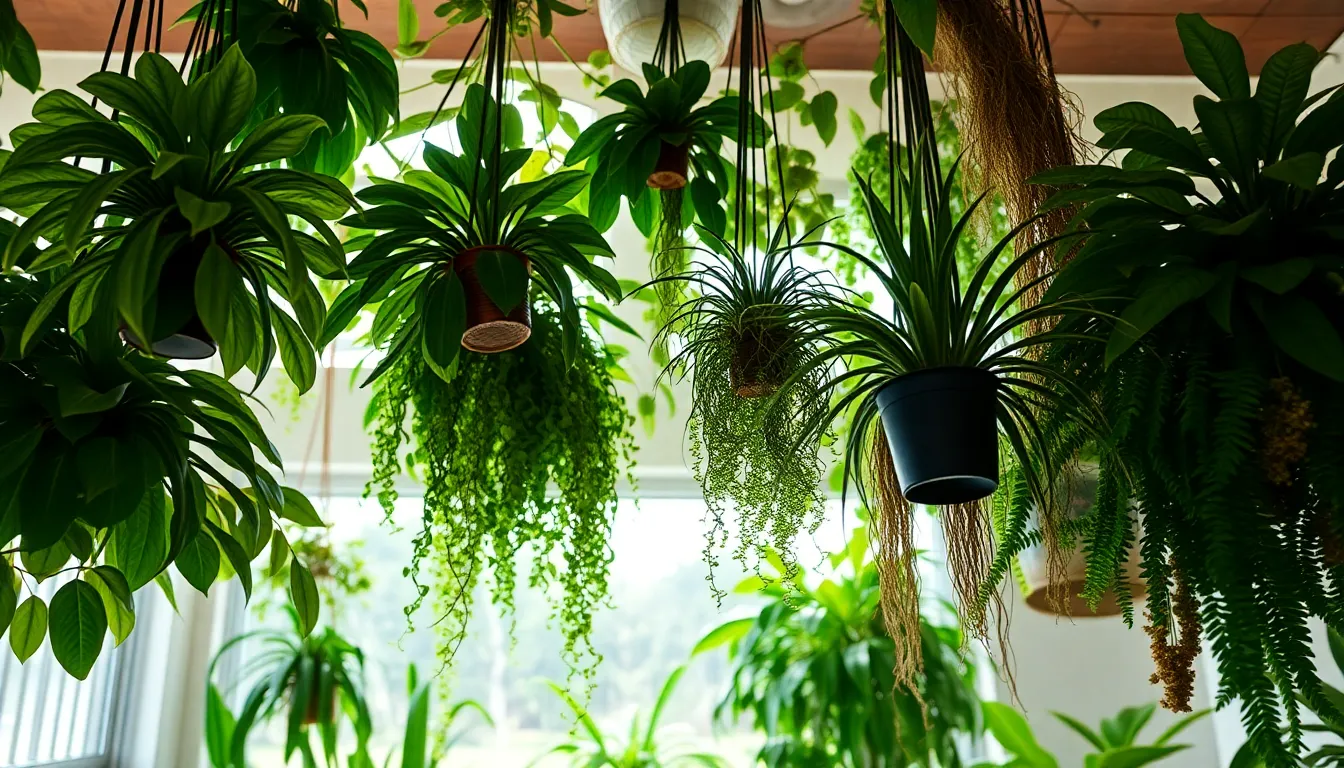
Selecting the right plants for your ceiling hanging displays requires considering light availability, growth habits, and maintenance needs. We’ll focus on varieties that thrive in suspended environments while creating stunning visual impacts.
Low-Light Hanging Plants for Indoor Spaces
Philodendron heartleaf adapts beautifully to low or moderate light conditions with its lush heart-shaped leaves and elegant trailing vines. This low-maintenance option tolerates irregular watering schedules, making it perfect for busy households.
Spider plants excel in indirect light settings and are known for their remarkably low maintenance requirements. These fast-growing favorites produce cascading foliage that quickly fills hanging baskets with green appeal.
English ivy provides classic trailing foliage that’s ideally suited for ceiling baskets in indirect indoor light. We recommend this variety for spaces where natural light is limited but you still want dramatic draping effects.
Boston ferns can survive in moderate light conditions while adding incredible lush greenery to your hanging displays. Though they prefer bright indirect light and humidity, these plants adapt well to various indoor environments.
Fast-Growing Trailing Varieties
Spider plants produce new offsets rapidly, creating dense cascading displays in just weeks. These classic choices grow quickly and require minimal care while providing instant visual impact.
Tradescantia creates vibrant trailing foliage that grows remarkably fast in suitable light conditions. We’ve found this variety builds impressive cascades that transform spaces within months.
Nasturtiums tolerate everything from full sun to partial shade while blooming profusely throughout their growing season. These trailing beauties cascade elegantly when hung and produce continuous colorful flowers.
Chenille plants offer dramatic trailing habits with their distinctive fuzzy red flower spikes. These rapid growers thrive in indirect light indoor spaces and create conversation-starting displays.
Air-Purifying Plants That Thrive When Suspended
Boston ferns filter indoor air pollutants while providing lush hanging greenery for your ceiling displays. These natural air cleaners remove toxins while creating beautiful cascading foliage.
Spider plants remove airborne toxins efficiently while growing exceptionally well in hanging baskets. We particularly appreciate how these plants combine air purification with easy care requirements.
English ivy is recognized for both its air-purifying qualities and trailing habit that’s perfectly suited for ceiling installations. This variety removes formaldehyde and other common indoor pollutants.
Philodendrons help purify indoor air while tolerating low light conditions in hanging arrangements. These versatile plants add greenery to any suspended display while improving your home’s air quality.
Install Proper Drainage Systems for Hanging Plants from Ceiling
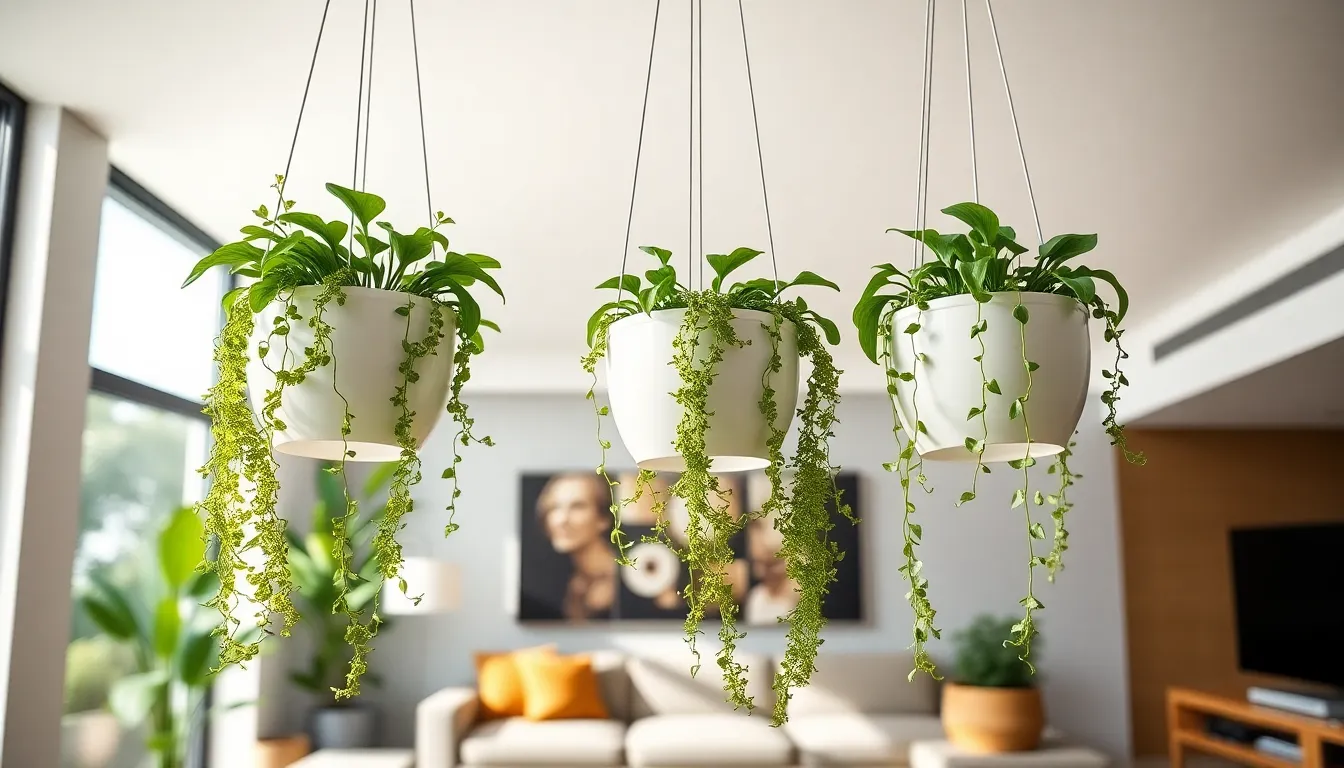
Water management becomes critical when you’re suspending plants above your living spaces. Protecting your floors and ceiling from water damage requires strategic planning and the right drainage answers.
Self-Watering Planters and Reservoirs
Self-watering planters offer the most comprehensive solution for ceiling mounted plant displays. These innovative containers feature built-in reservoirs that automatically supply water to your plants as needed, maintaining consistent moisture levels without the risk of overflow.
Built-in reservoir systems minimize watering frequency while reducing the chances of water leakage that can damage your home’s interior. We recommend these planters because they help prevent overwatering, which is one of the leading causes of ceiling and floor damage from hanging plants.
Consistent moisture control ensures your plants receive optimal hydration while protecting your investment in both plants and home furnishings. Automatic water distribution eliminates the guesswork from plant care and creates a safer environment for indoor gardening enthusiasts.
Drip Trays and Saucers
Drip trays serve as your first line of defense against water damage from hanging plants. These essential accessories catch excess water that naturally drains from your planters, preventing direct dripping onto floors and furniture below.
Silicone trays provide lightweight answers that won’t add important weight to your ceiling installation. Plastic saucers offer easy cleaning options and come in various sizes to accommodate different planter dimensions.
Positioning these protective barriers underneath every hanging planter ensures comprehensive coverage for your space. Regular emptying of collected water maintains the effectiveness of your drainage system and prevents stagnation that could attract pests.
Moisture-Wicking Materials
Moisture-wicking liners create an additional layer of protection inside your hanging planters. These specialized fabrics and materials absorb excess water that might otherwise leak through drainage holes.
Water absorption capabilities of these materials help draw moisture back into the soil as it dries, improving overall plant hydration efficiency. Fabric liners work particularly well with plants that prefer consistent moisture levels without waterlogged conditions.
Strategic placement of wicking materials inside planters reduces the frequency of water reaching drip trays below. Enhanced water retention means healthier plants and fewer maintenance concerns for your ceiling mounted garden displays.
Design Attractive Arrangements When Hanging Plants from Ceiling
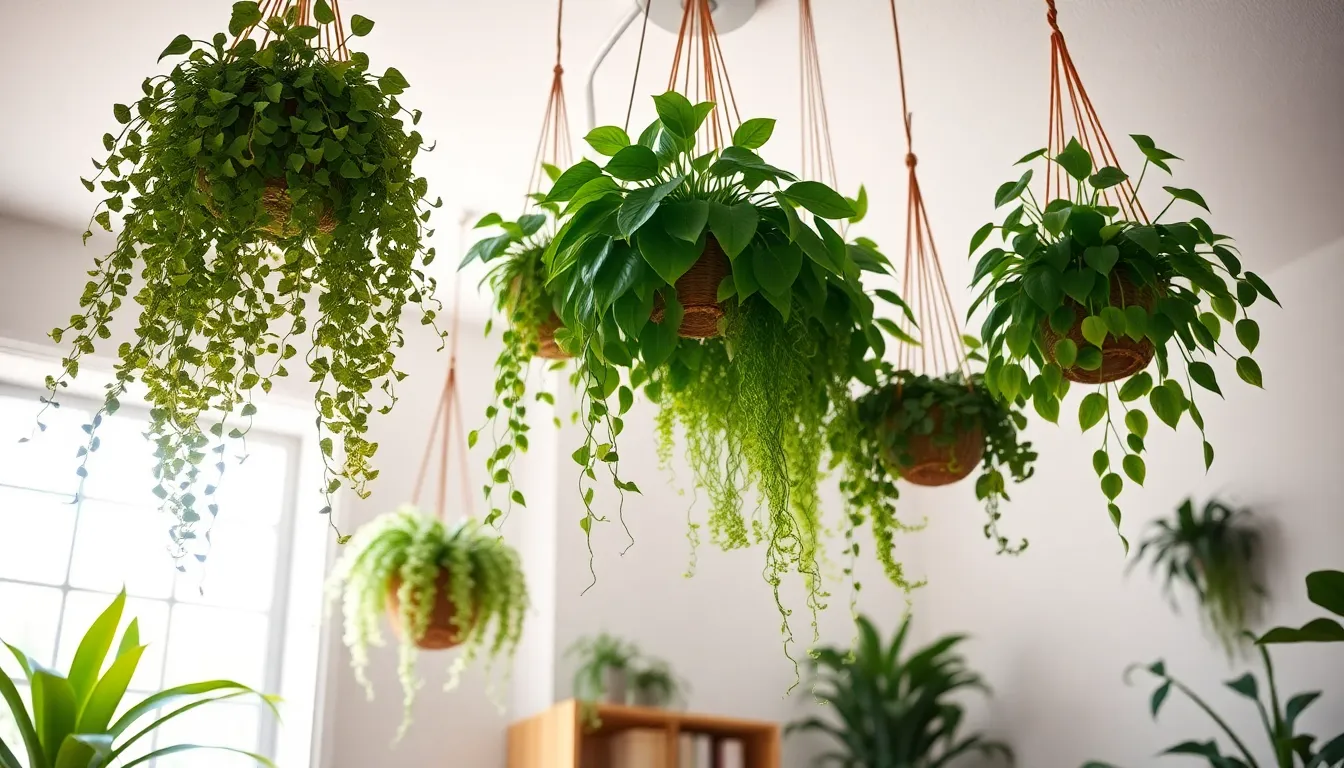
Creating stunning ceiling displays goes beyond just hanging plants randomly around your space. Strategic arrangement techniques transform ordinary hanging plants into eye-catching focal points that enhance your entire room’s aesthetic.
Create Visual Balance with Plant Heights
Varying hanging heights creates depth and visual interest in your ceiling garden display. We recommend measuring and marking precise lengths before installation to ensure plants hang at different levels rather than creating a flat, monotonous arrangement. Use a measuring tape to mark spots on your ceiling for consistent placement that draws the eye naturally around the room.
Staggered arrangements work better than uniform heights for achieving professional-looking displays. Position taller plants at different distances from the ceiling to create layers that add dimension to your space. This technique prevents your hanging garden from appearing cluttered while maximizing the visual impact of each individual plant.
Strategic spacing between plants ensures each specimen has room to grow while maintaining the overall composition. Leave adequate space between hangers to prevent plants from crowding each other as they mature and spread.
Group Plants by Similar Care Requirements
Clustering plants with matching water needs simplifies your maintenance routine significantly. Group together plants like English ivy, heartleaf philodendron, spider plant, devil’s ivy, and Boston fern since they share similar watering schedules and humidity preferences.
Light requirement groupings help ensure all plants in a cluster thrive in their shared location. Position sun-loving varieties near windows while placing low-light plants in interior areas where they’ll receive appropriate illumination without burning.
Humidity preferences determine successful plant partnerships in hanging arrangements. Tropical plants that enjoy higher moisture levels should be grouped together, while drought-tolerant varieties work better in separate clusters with different care schedules.
Mix Textures and Colors for Impact
Contrasting foliage textures create visual excitement in hanging displays. Pair trailing ivy with bushy ferns or combine smooth-leafed pothos with textured Boston ferns to add tactile interest that catches the eye from multiple angles.
Color variation enhances the overall aesthetic of your ceiling garden arrangement. Integrate different shades of green alongside variegated leaves to create depth and prevent monotonous displays that fade into the background.
Combining different growth patterns adds ever-changing movement to your hanging garden. Mix cascading varieties with upright growers and bushy specimens to create arrangements that change and evolve as plants mature and develop their natural forms.
Maintain Your Hanging Plants from Ceiling Setup
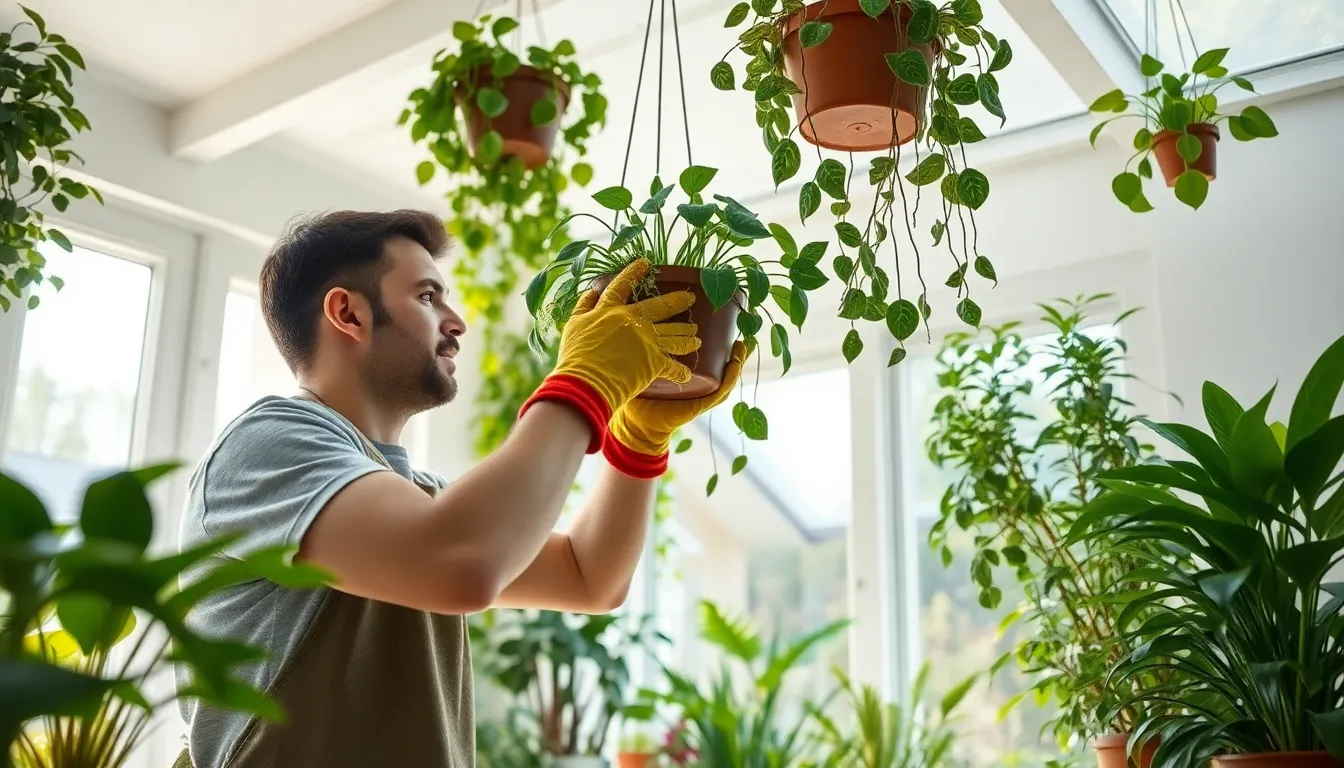
Regular maintenance ensures your ceiling-mounted plants remain healthy and your installation stays secure. We’ll guide you through essential care techniques to keep your elevated garden thriving.
Watering Techniques for Elevated Plants
Watering elevated plants requires strategic planning to protect your floors and ceilings from damage. We recommend placing towels or waterproof trays directly beneath plants during watering sessions to catch excess water. Remove plants from their hangers when possible and water them over a sink or outdoors for mess-free maintenance.
Choose lightweight pots with adequate drainage holes to prevent root rot and reduce overall hanging weight. Water slowly and steadily, allowing soil to absorb moisture gradually rather than flooding the plant. Self-watering planters eliminate frequent watering needs and provide consistent moisture levels for your suspended plants.
Monitor drainage carefully since excess water can drip onto furniture or create ceiling stains. Allow plants to drain completely before rehanging them to prevent mold or mildew development on surrounding surfaces. Consider moisture-retention soil mixes that reduce watering frequency while maintaining optimal plant health.
Pruning and Trimming Suspended Growth
Pruning suspended plants maintains their shape and prevents overcrowding that can affect hanging stability. Use sharp pruning shears to remove dead, yellowing, or damaged leaves promptly. Work carefully to avoid dropping debris on floors or damaging nearby plants during trimming sessions.
Trim overgrown stems regularly to encourage fuller, more balanced growth patterns. Focus on removing leggy growth that can make plants appear unbalanced and potentially unstable when hanging. Regular pruning promotes healthy new growth and maintains the attractive appearance of your ceiling display.
Inspect plants closely during pruning sessions for signs of pests or diseases that might be harder to spot from ground level. Remove any affected plant material immediately to prevent spread to other plants in your collection. Clean pruning tools between plants to avoid cross-contamination of potential problems.
Rotating Plants for Even Light Distribution
Rotating hanging plants weekly ensures all sides receive adequate sunlight for balanced growth. Turn each plant a quarter rotation during your regular maintenance routine to prevent one-sided growth patterns. Plants naturally lean toward light sources, so consistent rotation maintains symmetrical, attractive shapes.
Observe natural light patterns in your room throughout different times of day and seasons. Adjust hanging positions as needed to optimize lighting conditions for your exact plant varieties. Some plants may require relocation during winter months when natural light decreases significantly.
Monitor plant growth patterns to identify which specimens need more frequent rotation. Fast-growing trailing plants often require more attention than slower-growing varieties to maintain their desired appearance and prevent excessive reaching toward light sources.
Troubleshoot Common Problems with Hanging Plants from Ceiling
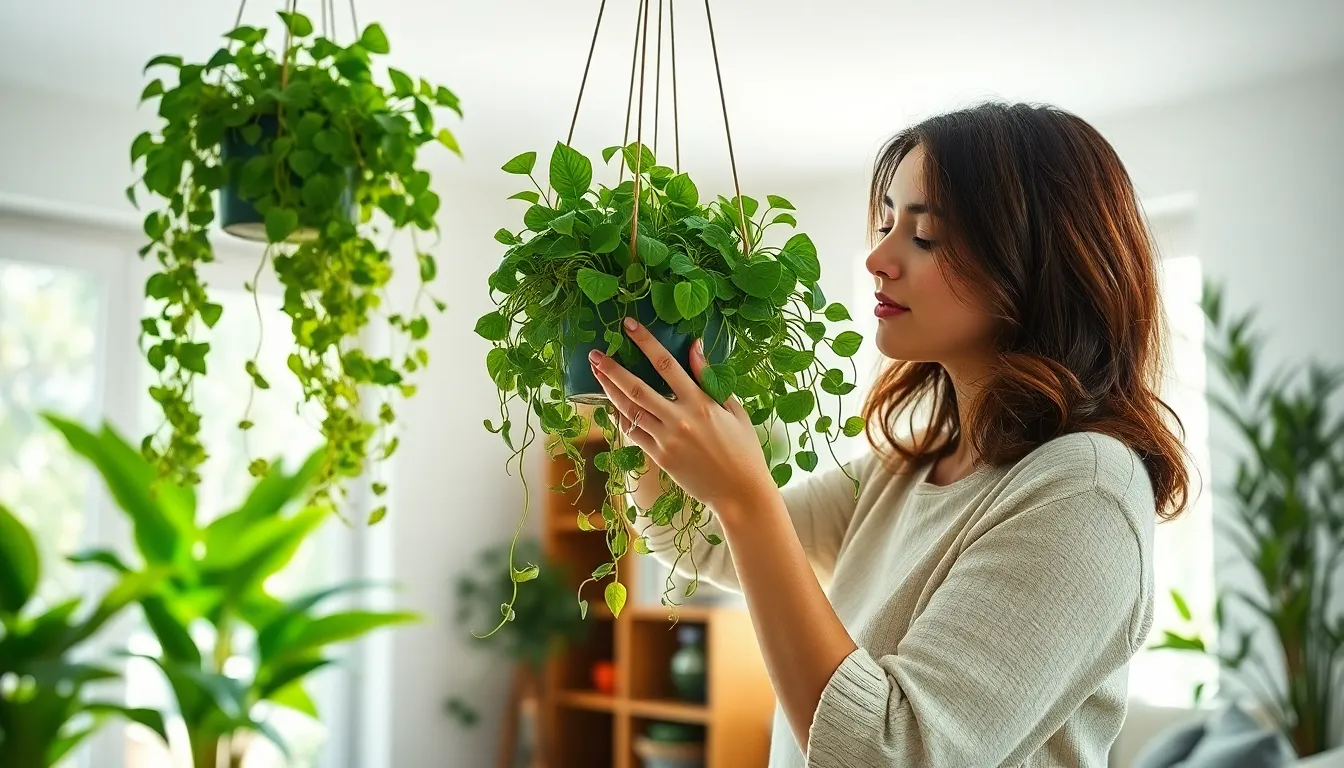
Even the most carefully planned ceiling gardens can encounter challenges that require quick answers. Let’s address the most common issues you’ll face with your elevated plant displays.
Prevent Overwatering and Root Rot
Overwatering ranks as the most frequent problem in hanging plant care and leads directly to root rot damage. Water your hanging plants thoroughly until water drains from the bottom, ensuring the soil feels heavy with moisture. Allow the top inch of soil to dry completely before your next watering session. Morning or late afternoon watering reduces evaporation and gives plants time to absorb moisture effectively.
Control your watering technique by using a long-spouted watering can or placing ice cubes on the soil surface. These methods prevent spills and provide steady moisture release without overwhelming the root system. Drainage holes in your planters are essential for preventing water buildup that causes root rot. Check that excess water can escape freely from your containers to maintain healthy root conditions.
Address Pest Issues in Elevated Gardens
Spider mites, aphids, and mealybugs commonly target hanging plants due to their elevated position and often stagnant air conditions. Inspect your plants weekly for early signs of pest activity, looking for webbing, sticky residue, or visible insects on leaves and stems. Avoid toxic pesticides that can harm indoor air quality and instead opt for gentle treatments like neem oil or insecticidal soap.
Maintain good air circulation around your hanging plants to naturally discourage pest infestations. Position fans nearby or ensure adequate space between plants to promote airflow. Regular plant rotation during your weekly maintenance routine helps you spot pest problems early and prevents them from spreading to neighboring plants.
Fix Drooping or Yellowing Leaves
Drooping and yellowing leaves typically indicate watering imbalances or insufficient light exposure in your hanging displays. Check soil moisture levels by inserting your finger into the top inch of soil to determine if the problem stems from overwatering or underwatering. Adjust your watering schedule accordingly based on what you discover.
Position your hanging plants near east-facing windows to provide bright, indirect light without causing leaf scorch. Rotate plants weekly to ensure all sides receive equal light exposure and prevent uneven growth patterns that cause drooping. Monitor your plants for signs of light stress, such as pale or scorched leaves, and adjust their position if needed to maintain healthy foliage.
Conclusion
We’ve shown you how ceiling-mounted plants can completely transform your living space while maximizing every square inch. From selecting the right hardware to choosing low-maintenance plants that thrive in your lighting conditions you now have all the tools needed for success.
Your new vertical garden will not only purify the air and add natural beauty but also create stunning focal points that impress everyone who visits. Remember to start with lightweight options and gradually expand your collection as you gain confidence.
The key lies in proper planning preparation and regular maintenance. With these strategies in place you’ll enjoy a thriving overhead oasis that brings nature indoors without sacrificing floor space or requiring major renovations.
Frequently Asked Questions
What are the main benefits of hanging plants from the ceiling?
Hanging plants from the ceiling maximize vertical space, save floor area, and create stunning visual displays without requiring extensive renovations. They revitalize indoor environments, improve air quality, and add natural beauty to any room while making spaces appear larger and more dynamic.
How do I ensure my ceiling can support hanging plants safely?
Identify load-bearing points in your ceiling structure and test the strength of ceiling materials before installation. Avoid mounting between joists unless using specialized anchors. For heavier plants, hire a professional installer and consider obtaining load calculations for insurance purposes.
What hardware should I use for hanging plants from the ceiling?
Choose hardware based on plant weight: eye hooks and screws for lightweight plants, toggle bolts for drywall installations, and heavy-duty ceiling anchors for heavier plants. Always select appropriate tools to prevent ceiling damage and ensure secure mounting.
Which plants work best for ceiling displays?
Select plants based on available light, growth habits, and maintenance needs. Low-light options like pothos and snake plants work well in darker areas, while air-purifying plants like spider plants enhance both aesthetics and indoor air quality.
How do I prevent water damage when watering hanging plants?
Use self-watering planters and drip trays to protect floors and ceilings. Choose lightweight pots with proper drainage holes, and water strategically to avoid overflow. Consider installing plants during dry weather to prevent moisture-related issues during setup.
How should I arrange multiple hanging plants for the best visual impact?
Vary plant heights to create depth and visual interest using staggered arrangements. Group plants with similar care requirements together for easier maintenance, and mix different textures and colors to add visual excitement to your ceiling garden display.
What maintenance do ceiling-mounted plants require?
Regular pruning maintains plant shape and health, while weekly rotation ensures even light distribution. Monitor watering carefully using lightweight containers with drainage, and inspect plants regularly for pests while maintaining good air circulation to prevent infestations.
How do I fix common problems like drooping or yellowing leaves?
Adjust watering schedules and light exposure to correct drooping or yellowing leaves. Prevent root rot by managing watering techniques and ensuring proper drainage. Address pest issues promptly and maintain good air circulation to keep plants healthy and thriving.

